Yes, you can day trade with CFDs—and many traders do. In fact, CFDs are often used for short-term trading because they allow you to take advantage of small price movements without owning the asset itself. But before jumping in, it’s important to understand how this works and what makes it different from other trading styles.
Day trading means opening and closing trades within the same day. You’re not holding positions overnight. The aim is to catch price movements during the day, whether they’re big or small. With CFDs, this is possible because of the way contracts are designed. You simply enter a trade based on whether you think the price will go up or down, then close it when your target or limit is reached.
One of the reasons online CFD trading works well for day traders is the speed and flexibility it offers. You can access different markets—including shares, currencies, indices, and commodities—all from one account. Prices update in real time, and trades can be placed within seconds. This lets you react quickly to market news or short-term price changes.
That said, day trading with CFDs isn’t about luck or guessing. It takes planning and discipline. Since you’re working with shorter timeframes, timing is everything. Many traders use charts and technical tools to spot patterns or trends. These can help you decide when to enter or exit a position, especially when markets are moving quickly.
Another key factor is leverage. CFDs often allow you to trade using more than what you deposit. This means a small price movement can lead to a bigger return—or a larger loss. Day traders usually set tight stop-loss and take-profit levels to manage this risk. In online CFD trading, these tools are easy to set up and can help keep your account safe when the market shifts suddenly.
Costs are something to watch too. While there’s no commission on many CFD trades, you still pay through the spread—the difference between the buying and selling price. Since day traders open several positions in a single day, these small costs can add up. That’s why it’s important to keep your trades focused and avoid jumping in without a clear reason.
Some traders think day trading means making money every day. But that’s not always the case. Markets don’t move the same way all the time. Some days are active and full of chances, while others are slow and offer little movement. Knowing when to stay out is just as important as knowing when to trade.
Another helpful point is that many online CFD trading platforms offer demo accounts. These are great for practising day trading without risking real money. You can test how different markets behave and see what kind of trades match your style. If your strategy works well in a demo setting, it’s a good sign you might be ready to try it live—with proper risk limits in place.
Discipline is what sets successful day traders apart. It’s easy to overtrade or chase losses when things don’t go as planned. But if you treat day trading like a skill and not a game, you’ll be more likely to grow over time.
To sum up, day trading is possible with CFDs and can offer fast-paced opportunities. But like any type of trading, it comes with risk. The right mindset, tools, and preparation make all the difference. With proper care, short-term trading can become a useful part of your overall strategy. It’s not about chasing every price move—it’s about knowing when to act and when to step back. Even small, consistent gains can add up when supported by a solid approach.

